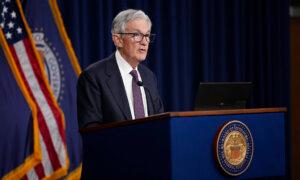President Donald Trump says the Federal Reserve cutting interest rates would be “jet fuel” for the U.S. economy.
Throughout May 8, Trump took aim at Fed Chair Jerome Powell on social media and at a White House event announcing a new U.S.–UK trade agreement.
Speaking to reporters at the Oval Office, Trump stated that central banks worldwide are cutting interest rates, except for the Federal Reserve. If Powell lowered interest rates like the United Kingdom and other countries, it would be “like jet fuel” for the U.S. economy, Trump said.
“But he doesn’t want to do it,” the president said. “I think he doesn’t want to do it. Probably he’s not, he’s not in love with me. I think that’s, it’s sort of a crazy reason, but that’s the way life is.”
The Federal Reserve voted on May 7 to leave interest rates unchanged for the third straight meeting.
Investors in the futures market don’t expect a rate cut until July, based on data compiled by CME FedWatch.
Trump’s remarks came shortly after he took to social media and derided Powell for not cutting interest rates.
Several central banks have been lowering interest rates to cushion the potential economic blows from U.S. tariffs. The latest institution was the Bank of England.
The nine-member Monetary Policy Committee voted on May 8 to reduce its main interest rate by 25 basis points amid possible tariff-driven economic disruptions and easing inflationary pressures.
“The past few weeks have shown how unpredictable the global economy can be,” said Bank of England Gov. Andrew Bailey. “That’s why we need to stick to a gradual and careful approach to further rate cuts.”
Powell, talking to the media at the post-meeting press conference, reiterated his stance that the monetary authorities do not need to be in a hurry to adjust policy.
“We think we can be patient,” Powell said. “The risks of higher unemployment and higher inflation appear to have risen, and we believe that the current stance of monetary policy leaves us well positioned to respond in a timely way to potential economic development.”
When reporters asked Powell if Trump’s continued criticism of his performance impacts the Fed’s job or how it crafts monetary policy, he stated it has no effect at all.
“We are always going to do the same thing, which is we are going to use our tools to foster maximum employment and price stability for the benefit of the American people,” he said. “We are always going to consider only the economic data, the outlook, the balance of risks, and that’s it. That’s all we are going to consider.”
State of the US Economy
The Fed offered a mixed assessment of the U.S. economy.
Although indicators point to resilient economic activity, officials have developed stagflation concerns as higher unemployment and inflation risks have risen.
At the same time, according to Powell, tariff effects have not shown up in the hard data. Still, it does not mean the United States will avert possible adverse effects of the administration’s changes to fiscal, immigration, regulatory, and trade policy.
“If the large increases in tariffs that have been announced are sustained, they are likely to generate a rise in inflation, a slowdown in economic growth, and an increase in unemployment,” Powell said. “The effects on inflation could be short-lived, reflecting a one-time shift in the price level. It is also possible that the inflationary effects could instead be more persistent.”
Trump has previously stated that the Fed risks an economic slowdown if it does not cut rates.
The U.S. economy could rebound in the second quarter despite the first-quarter contraction and growing recession odds.







